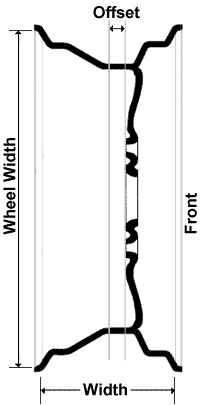
Wheel offset is the distance from the centre of the wheel to the face of the bolting plate.
Effectively the wheel offset is also the distance from the centre-line of the wheel to the hub face.
Therefore :
If you put a wheel on the same hub with a bigger wheel offset, the wheel will sit further inside the wheel arch because the wheel's bolting face will have to move further in to meet the hub.
 Alternatively
if it has a smaller wheel offset it will sit further out from the wheel arch.
Alternatively
if it has a smaller wheel offset it will sit further out from the wheel arch.
For sports purposes grip would be improved by increasing the width of the wheel (and tyre) and using a smaller wheel offset to allow for the extra width on the wheel in the wheel arch.
Vehicle wheels are usually described with a designation of something like '13-5.5J' and this is decoded as follows.
The 13 is the diameter of the wheel in inches from edge to edge, measured inside the flange with sizes ranging from 10 inch on the original Minis to 23 inch on 4×4 vehicles.
The second number is the width of the rim, again measured in inches between the flanges. The original Mini used 4.5 wheels and sizes range all the way up to 12 as used on some supercars.
The letter, in this case J refers to the shape of the rim. Rim contours are standardized by the Tire and Rim Association, so that tires will fit.
Another important thing is the wheel offset, explained above. The offset is described by the term ET, which is from the German word 'Einpresstiefe' translated as 'insertion depth'. Most wheels have a positive wheel offset which means the mounting surface is further outboard than the wheel's centre. If you reduce the amount of positive ET on the wheel the the vehicles track is widened and vice versa if the ET number is reduced. Straying too far from the original wheel offset can be detrimental as fouling to the suspension and bodywork can occur as well as excess strain on wheel bolts or studs.